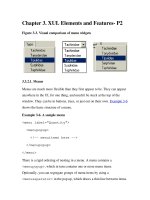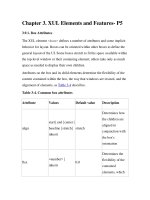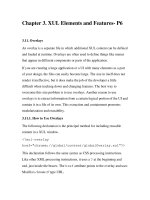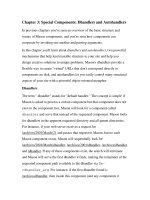magento sample chapter 3 categories and attributes
Bạn đang xem bản rút gọn của tài liệu. Xem và tải ngay bản đầy đủ của tài liệu tại đây (1.54 MB, 39 trang )
Magento
Beginner's Guide
William Rice
Chapter No. 3
"Categories and Attributes"
www.besthosting4magento.com
For More Information:
/>
In this package, you will find:
A Biography of the author of the book
A preview chapter from the book, Chapter No 3 "Categories and Attributes"
A synopsis of the book’s content
Information on where to buy this book
About the Author
William Rice is a software training professional who lives, works, and plays in New York
City. He is the author of two books on Moodle—
Moodle E-Learning Course
Development
and
Moodle Teaching Techniques
. His indoor hobbies include writing
books and spending way too much time reading sites such as Slashdot and www.ted.org.
His outdoor hobbies include orienteering, edible wild plants, and practicing archery
within sight of JFK Airport. William is fascinated by the relationship between technology
and society: how we create our tools, and how our tools in turn shape us. He is married to
an incredible woman who encourages his writing pursuits, and has two amazing sons.
For More Information:
/>
Magento: Beginner's Guide
Magento is the world's most evolved e-commerce solution. It runs on the
Apache/MySQL/PHP platform. From a single installation you can control multiple
storefronts, all of which share the customer and product information. Magento's templates
and themes enable you to customize the look and feel of your store, even optimizing it
for mobile phones. Magento's extensions enable you to connect it to a large number of
payment gateways and shipping services. Modular code enables you to upgrade your
Magento installation while retaining your customizations. Support is provided free of
cost by an active open source community, and also by subscription to Varien—the
company behind Magento.
This book provides guidance in the form of a step-by-step approach to building a simple,
effective online store. The book covers the key features of Magento that will help you get
your store up and running. It guides you through installation, configuration, populating
your store with products, accepting payments, maintaining relationships with your
customers, and fulfilling orders.
When you create an online store with Magento, you usually follow a defined series of
steps. This book is arranged to support that process. Each chapter shows you how to get
the most from one step.
You will learn to customize the default Magento storefront, so that it becomes your store.
You will also learn about Magento's directory structure, and where some of the elements
of a store are customized. This experience will help you if you decide to go beyond this
book and install new themes, or create your own themes.
As you work your way through each chapter, your store will grow in scope and
sophistication. By the time you finish this book you should have a basic, but complete,
working online store.
For More Information:
/>
What This Book Covers
Chapter 1
focuses on what you can do with Magento and a walk-through of a store using
the features we will cover.
Chapter 2
covers the installation of Magento on a low-cost hosting service.
Chapter 3
focuses on creating categories and attributes, a necessary step before you
can build your catalog of products.
Chapter 4
focuses on the configuration of tax rates and rules to automatically apply
the correct sales tax based upon the type of product and the purchaser's location.
Chapter 5
focuses on adding products to your store with detailed descriptions, images,
and inventory information.
Chapter 6
focuses on the customization of the default storefront to make it your own.
Chapter 7
focuses on presenting related products to your shoppers, offering products
for sale in sets, and giving your customers options such as size, color, manufacturer,
and more.
Chapter 8
focuses on managing customer accounts and configuring store contact options.
Chapter 9
focuses on configuring Magento's default payment options such as PayPal,
credit cards, check/money order, and purchase orders.
Chapter 10
focuses on offering customers a variety of shipping options, connecting to
shippers such as UPS, FedEx, and USPS, and creating customized shipping rates.
Chapter 11
covers the walk-through of fulfilling an order and discovering options for
handling order fulfillment, by observing the lifecycle of an order in Magento.
Appendix
A
has step-by-step directions in one place, and eliminates the explanations and
so that you get just the steps you need.
For More Information:
/>
3
Categories and Attributes
T
I B
A
Categories, Products, and Attributes
Products are the items that are sold. In Magento, Categories organize your Products, and
A describe them. Think of a Category as the place where a Product lives, and an
A P E P
C A P A
Is it a Category or an Attribute?
Some things are clearly Categories. For example, if you have an electronics store, MP3 players
would make a good Category. If you're selling jewelry, earrings would make a good Category.
O A C SKU
A
S C A F
I A
H
C T
S A C
or both? The answer depends upon what kind of shopping experience you want to create for
your customers.
For More Information:
/>
C A
[ 46 ]
Examples
T C P A
Category 1
Product 1
A
A
P
A
A
C
Product 3
A
A
Product 4
A
A
W
Single Origin
H K
Grind (whole bean, drip, French press)
Roast (light, medium, dark)
Blue Mountain
Grind
Roast
Blends
Breakfast Blend
Grind
C
A C
Grind
C
For More Information:
/>
C
[ 47 ]
In Magento, you can give your shoppers the ability to search your store. So if the shoppers
B M Search
H
T W
S O
B T H K B M
B B A C
A P A I
store, shoppers can select Grind for any of the products. For Single Origin, they can also
R F C T M
T P
N C P A
in detail. Then, we can start adding products.
Categories
Product Categories are important because they are the primary tool that your shoppers use
to navigate your store. Product Categories organize your store for your shoppers. Categories
can be organized into Parent Categories and Subcategories. To get to a Subcategory, you drill
down through its Parent Category.
Categories and the Navigation Menu
If a Category is an Anchor Category N M T
"Anchor" makes the category sound as if it must be a top-level category. This is not true.
You can designate any category as an Anchor Category. Doing so puts that category into
N M
W C N M
and any subcategories are displayed. When a shopper selects an Anchor Category from the
menu, Magento does not display the normal list of subcategories. Instead, it displays the
A P I
A P A
C C T N M not
You don't create any Categories, or
You create Categories, but you don't make any of them Anchors, or
Your Anchor Categories are not subcategories under the Default Category.
For More Information:
/>
C A
[ 48 ]
T N M
You have created at least one Category
You have made at least one Category an Anchor
You have made the Anchor Category a Subcategory under Default.
W M P P
F I
you create at least one Anchor Category before you start adding Products to your store. As
you add each Product, add it to an Anchor Category. Then, the Product will display in your
store, and you can preview it. If the Anchor Category is not the one that you want for that
Product, you can change the Product's Category later.
B P A C S
Origin and Blends. As we add Products, we will assign them to a Category so that we can
preview them in our storefront.
Making best use of Categories
T C T
H
1.
are looking for.
H
matches their desires.
E
3.
your store.
We would like to organize our store so that our Categories accomplish all these goals.
H
F I
your store sells MP3 players, including Apple iPods. A Category called iPods would help the
P H iPods
Category doesn't do much to help shoppers who know that they want an MP3 player, but
don't know what kind.
On the Web, you usually search something when you know what you want. But when you're
not sure about what you want, you usually browse. In an online store, you usually begin
C W C
try to make them helpful for shoppers who almost know what they want.
For More Information:
/>
C
[ 49 ]
H
C C
Again, suppose you have an electronics store that sells a wide variety of items. If a high
percentage of your customers want iPods, it might be worthwhile to create a Category just
for those few products. The logs from the S
determine whether your shoppers are interested in a narrow Category of a Product. Are 30
I
create a top-level Category just for those Products.
Attributes
A A P N SKU
A
System versus Simple Attributes
N SKU P
M M A
assign a value for each of them. These are called System A.
T A T
created by the store owner. They are called Simple A W
A S A
Attribute Sets
N S O A G R A
A G C
Single Origin
H K
Grind (whole bean, drip, French press)
Roast (light, medium, dark)
Blue Mountain
Grind
Roast
Blends
Breakfast Blend
Grind
C
A C
Grind
C
For More Information:
/>
C A
[ 50 ]
I A G R C N
A A S G
R G C T A
each Product.
A P T A S
and then a set can be applied to a Product. This means that you will need to create a set
A Y S
A GR O
P A S O A
I P A P
F S O
A G R I A
A
S O A
I P A
A F S O A
Grind and Roast, while others will use just Roast, then it would not make sense to create
S O A I GR
called Roast.
Three types of Products
I M P S C
G T P
Simple Product
A Simple Product P A A
saying goes, "What you see is what you get." The customer does not get to choose anything
about the Product.
I S P
I A
P
A S P F
H K
B A
a good Simple Product.
For More Information:
/>
C
[ 51 ]
Conigurable Product
A C Product P A
T H T
something about the Product.
A C P
B
C P
Grouped Product
A Grouped Product is several Simple Products that are displayed on the same page. You can
force the customer to buy the group, or allow the customer to buy each Product separately.
T H
Products, you will need to know more about each type of Product. When we
discuss Products later in this book, you will learn more about each of these.
Putting it together
I P C A A
P C C A
A C A
a Product.
I recommend that before you add Products to your store, you create the Anchor Categories
into which you will place those Products. This enables you to preview how those Products
I A S
for those Products.
L I
Create some Anchor Categories.
1.
C A S
Add a few Products.3.
For More Information:
/>
C A
[ 52 ]
Time for action: Creating Categories
I C W A C
P A
Before you begin
As Categories are the main tools for organizing your store, it is important to make best use of
P C W W
A N
Menu is limited. So, choose your Anchor Categories carefully.
T A C B
you can also create non-Anchor Categories and Subcategories.
L A P
1.
Select Catalog | Manage Categories
For More Information:
/>
C
[ 53 ]
N C Default
You are going to add your new Category under Default. Doing this will create
S T A C
are children of the Default C N M
You can add Categories so that they are not under the Default Category. They
will be at the same level as Default H C Default
N M I C
Default, you will need to create some other way for your customers to get to
that Category.
F C N S O C is under
Default, while I don't appear in the Nav Menu
T N M Single Origin C
For More Information:
/>
C A
[ 54 ]
Select the 3. Default Category.
Click on
4. Add S. A blank, New Category
E 5. Name for the Category. This will display in your storefront. In our example,
we will enter S O C
F 6. Is A Yes makes the Category visible to customers.
S No will hide this Category and its Subcategories in your store.
B C N M Yes.
For More Information:
/>
C
[ 55 ]
The 7. URL Key enables you to enter a search-engine-friendly path for this Category.
In this example, I entered so that when a shopper selects this
Category, the address in their browser reads .
I M C
Y
The
8. D that you enter here will appear on the Category's landing page.
The
9. Image that you upload will also appear on the Category's landing page.
H
For More Information:
/>
C A
[ 56 ]
The default Magento template will re-size the Category's image so that it is
475-pixels wide. If you upload an image that is taller than it is wider, the image
will take up a lot of space on the landing page. For example, I've uploaded an image
M
N
For More Information:
/>
C
[ 57 ]
A I
I
space. And, I want the gradient to show through. I solved both problems with this
Because the image is already 475-pixels wide, Magento did not re-size it. The result
A full discussion of working with graphic images is beyond the scope of this
H C
pages. Design the subject of the graphic according to the size you want. In this
A T
475-pixels wide. Finally, make the background transparent. The result will be
an image that is the right size for your landing page.
For More Information:
/>
C A
[ 58 ]
The 10. Page Title T Name.
The Name N M
The Category's Name and Page Title
Y
O
so that both search terms will be covered by this one page.
11. The Meta Keywords and M D HTML
E
to properly categorize this page.
A I
T
Webmasters use meta tags to tell search engines about a page and help the
You can see the meta tags in a page if you view the pages' source code. The
Single Origin
C N
<!DOCTYPE html PUBLIC "-//W3C//DTD XHTML 1.0 Strict//EN"
" /> <html xmlns=" xml:lang="en"
lang="en">
<head>
<title> Single Origin Coffee from Brew-Me-A-Cup -
Default Store View </title>
<meta http-equiv="Content-Type" content="text/html;
charset=utf-8"/>
For More Information:
/>
C
[ 59 ]
<meta name="description" content="single origin coffees"/>
<meta name="keywords" content="single origin coffee"/>
U Meta Keywords and M D
search engines.
For
Display Mode, select Products only. This will cause the Category's landing page
to display a list of products from that Category.
You can also select S only or S and products. We are
S B
beginner's guide.
I S B
13. CMS B
B F
W C S
14. Is Anchor,
we will choose Yes.
Click on the
15. Save Category
T G I C T
16.
C P C D W
We have done everything to get this Category to work in our store.
What just happened?
You now have at least one Anchor Category under the Default category. This new Anchor
Category has its own landing page, which you customized with text and a graphic. The
Products under this Anchor Category will be listed on its landing page.
Have a go hero
Now that we have an Anchor Category, we can press ahead and complete the other steps
O C F
C
Single Origin
C
L A
African
H
B C
For More Information:
/>
C A
[ 60 ]
S O B A T
O C P A S
Time for action: Creating Attributes
I A F A
Then, we will create the set.
Before you begin
B A P
P A W
P M A W
P M A
A A S E A Y
P I
A S S O
B T F S O A
W A
O
For More Information:
/>
C
[ 61 ]
S O A
Name
D
Image
Grind
Roast
Origin
SKU
Price
Size
B A
Name
D
Image
Grind
Roast
SKU
Price
Size
N A
T A A S
If you haven't already, log in to your site's backend, which we call the
1.
A P
For More Information:
/>
C A
[ 62 ]
S C A M A.
A A T
S A color, cost, and are visible to your
O A P
never see them. For example, custom_design can be used to specify the name of a
custom layout, which will be applied to a Product's page. Your customers will never
see the name of the custom layout.
W
For More Information:
/>
C
[ 63 ]
3. Click the Add New A T N P A
T P and Manage L O. You are in
the P tab.
The A P M
T
A T Frontend P
A W
4.
A C A Y
Y A
R A S T A
A C T A C
A
The Scope A Store View, W, or G. For
now, you can leave it set to the default—Store View. The other values become useful
M
That is beyond the scope of this quick-start guide.
For More Information:
/>
C A
[ 64 ]
A A P A
F
Y
for that Product.
N A F color,
T
R M F -
F
numbers, and that requires you to use two decimal places. And for image, you would
T Catalog Input Type for Store Owner enables you to select the kind of data
A
I A roast. When we assign this value
P S
we will select Dropdown.
If you select Dropdown or M Select Manage
LO tab, you will need to enter the list of choices (the list of values) for
6. If you select Yes for Unique Value, then no two products can have the same value
A F I
roast A
L
F E F A
roast H A SKU of the
Product, then I might want to make it unique. That would prevent me from entering
SKU P
7. If you select Yes for Values Required, then you must select or enter a value for this
A Y P A
blank. In the case of roast, it makes sense to require a value. Our customers would
For More Information:
/>
C
[ 65 ]
8. I V S O causes Magento to check the value entered for an
A W
A M
warning message.
9. The Apply To P T A
to them. Remember that the three Product Types in Magento are Simple, Grouped,
C R
one roast, then it would be a Simple Product. And, if the customer gets to choose
C P S Simple
Product and C P for the Apply To
But what about Grouped Product W
in one package, which would make it a Grouped Product. For example, we might
G P H K
J B M W I C
I A roast G P
would be required to have the same roast.
H K B M
S
A roast to Grouped Products. When we sell
Y P T A I
A
should be applied to which Products. So, you can safely choose All Product Types for









